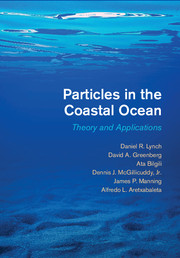Book contents
- Frontmatter
- Dedication
- Contents
- About the Authors
- Preface
- Acknowledgments
- List of Acronyms
- Definitions and Notation
- Introduction and Scope
- Part I Background
- Part II Elements
- Part III Applications
- 9 Noncohesive Sediment – Dense Particles
- 10 Oil – Chemically Active Particles
- 11 Individual-Based Models – Biotic Particles
- Part IV Appendices
- A Series, Sums, Limits
- B Complex Numbers
- C Wiener Integrals
- D Rates and Rate Limiters
- E Diffusion Solutions
- F Covariance Matrix for Shear and Convergence
- G Summary – ARn Recursions
- H Distribution Properties for Linear Triangles
- Bibliography
- Index
- Plate Section
10 - Oil – Chemically Active Particles
from Part III - Applications
Published online by Cambridge University Press: 05 January 2015
- Frontmatter
- Dedication
- Contents
- About the Authors
- Preface
- Acknowledgments
- List of Acronyms
- Definitions and Notation
- Introduction and Scope
- Part I Background
- Part II Elements
- Part III Applications
- 9 Noncohesive Sediment – Dense Particles
- 10 Oil – Chemically Active Particles
- 11 Individual-Based Models – Biotic Particles
- Part IV Appendices
- A Series, Sums, Limits
- B Complex Numbers
- C Wiener Integrals
- D Rates and Rate Limiters
- E Diffusion Solutions
- F Covariance Matrix for Shear and Convergence
- G Summary – ARn Recursions
- H Distribution Properties for Linear Triangles
- Bibliography
- Index
- Plate Section
Summary
Introduction
Oil is a particular case of a chemically active substance. Of interest here is its oceanic transport, chemical transformations, and fate. In the present context (high abundance, small space/time scales) oil is not “natural” in the sea, but is introduced unintentionally by accidents – spills, exploration/production blowouts – or clandestinely by dumping of waste products.
Oil is not a pure substance, but a mixture of hundreds of specific compounds. For the commercially common oil products, there are large databases of chemical composition and properties. Some are maintained by government agencies, some by transboundary corporations or their associations; some are embedded in operational models. Crude oils are distinctive and discernible, by origin; refinery products are quite specific about chemical properties, and subject to commercial norms of identity and quality.
Generally, oil will be a buoyant liquid mixture, immiscible in water, with density, viscosity, and other physical properties sensitive to its weathering history. In the sea it will occur either as a surface slick or as subsurface droplets. It will be transported by oceanic motion while weathering. Evaporation tends to account for the lion's share of most surface spills, unless a slick makes landfall early or emulsifies. Exposure in the environment will alter the chemical mix and its bulk properties. Destinations for present purposes include the sea floor, mingled with the benthos; the shoreline; in the biota; in the atmosphere as evaporation products. Some subsurface oil will dissolve or biodegrade in the sea.
We use parcels to represent discrete quantities of oil in the environment. A parcel may be floating at the surface as a slick, or submerged as an aggregation of identical small droplets. Each parcel moves as a Lagrangian particle; its content is subject to the operative processes summarized in Figure 10.1. A surface parcel could be thought of as a “spillet” – a physically well-defined subdivision of a larger spill.
- Type
- Chapter
- Information
- Particles in the Coastal OceanTheory and Applications, pp. 337 - 388Publisher: Cambridge University PressPrint publication year: 2014



